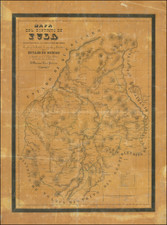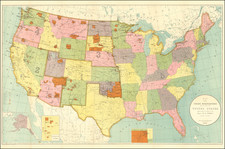First American Atlas Map To Illustrate Mexico Following the Adams-Onis Treaty and Treaty of Cordoba. The Rare 1827 Edition of the Map.
A fine map of the newly Independent Mexico, published the year following the effective date of the Adams Onis Treaty (February 22, 1821) and the Treaty of Cordoba (August 24, 1821) recognizing Mexico's independence from Spain.
The map captures the state of knowledge of Texas, the American Southwest and Mexico at the time of Stephen Harriman Long's return from his exploring expedition to the Rocky Mountains. The map makes note of the Long's location of the Arkansas River, along with Humboldt's note on its headwaters.
The map was published shortly before Austin's arrival in Texas and shows Bexar as the "capital of the province of Texas."
An early incomplete depiction of the Great Salt Lake is given, with "the western limits of this Salt Lake" unknown. To the south, the Colorado River and Gila Rivers are shown, along with numerous Indian Tribes.
Through New Mexico, the course of the Rio Grande River and the Spanish Missions along the Camino Real are well-illustrated, extending north to Taos, with the Santa Fe Trail located.
The best atlas map of Mexico published in America in the first half of the 19th century.
Henry Charles Carey (1793-1879) was an American geography publisher and businessman. He was the son of Mathew Carey and carried on the family publishing company in partnership with his brother-in-law, Isaac Lea. Henry worked in his father’s business from a young age. At twelve, he managed a store selling his father’s publications. At fifteen, he was the firm’s financial manager. In 1817, he became a junior partner, which changed the company’s name to Carey & Son.
In 1822, Mathew Carey brought in a new junior partner, Isaac Lea, who had married Henry’s sister, Frances Anne. In the same year, Mathew Carey left the business, with Henry buying out his father’s share. His younger brother briefly joined the business, but left by 1829, when the firm was named Carey & Lea. William A. Blanchard joined the firm in 1833, causing another name change to Carey, Lea & Blanchard. Henry retired in 1835, leaving the firm as Lea & Blanchard.
Henry had outside interests, including political economy. He published Principles of Political Economy in 1837. He also wrote Past, Present, and Future (1848), Principles of Social Science (1858-1860), and The Unity of Law (1872). In the 1850s, he was very active in organizing the nascent Republican Party. He died in 1879.
Isaac Lea (1792-1886) was an American publisher and geologist. Raised a Quaker in Delaware, he turned away from pacifist teachings and joined the militia in the War of 1812. After marrying Frances Anne, the daughter of publishing magnate Mathew Carey, Lea became a junior partner of Carey & Son in 1822. Mathew Carey left the firm in the same year and Isaac Lea worked primarily with his brother-in-law, Henry Charles Carey.
The pair conducted business as Carey & Lea, during which time they published A Complete Historical, Chronological and Geographical Atlas from 1822 to 1827. This work included roughly twenty maps engraved by Fielding Lucas Jr., as well as an American edition of Starling’s Cabinet Atlas. However, the firm increasingly turned away from cartographic publications.
By 1829, after the brief participation of Edward Carey, Henry’s younger brother, the company became known as Carey & Lea. William A. Blanchard joined the firm in 1833, causing another name change to Carey, Lea & Blanchard. Henry retired in 1838, leaving the firm as Lea & Blanchard.
Isaac Lea was not just a publisher, but an avid researcher with aptitude for geology. He was a member of the American Academy of Natural Sciences and the American Philosophical Society. He retired from publishing in 1851 and turned increasingly to geological research, results of which he published until his death in 1886.









![[Texas Coast] Partie Du Mexique Amer. Sep. No. 60.](https://storage.googleapis.com/raremaps/img/small/93536.jpg)
![[Dallas / Kennedy Assassination] La Mappa Dell'Odio](https://storage.googleapis.com/raremaps/img/small/89006.jpg)

![[Troops in the Mountains of North America] Nordamericanische Truppen auf einem Gebirgszug](https://storage.googleapis.com/raremaps/img/small/91333.jpg)
![[Printed on Linen] Map of Texas and Loyal Colonies Sometimes Referred To As The United States](https://storage.googleapis.com/raremaps/img/small/93363.jpg)
